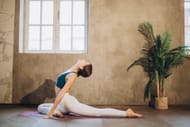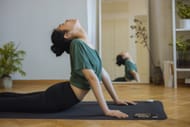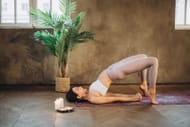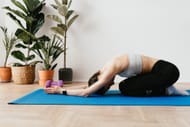Yoga poses are essential for achieving flexibility, which is one of the crucial aspects of decent physical health. Flexibility has several benefits for the body, including better mobility of joints and muscles, strengthening of the body, reducing stress, preventing and managing back pain, and so on.
However, various reasons such as improper posture, stress, bad movement habits, and an unhealthy lifestyle may lead to loss of flexibility in your body.
Here, we have carefully curated a list of effective yoga poses that will help in improving flexibility and preventing back pain. These yoga poses will help you prevent and manage back pain by enhancing spinal muscles, building core strength, and providing basic spinal flexibility.
Effective yoga poses for improving flexibility to prevent back pain
1. Downward facing dog

One of the most effective yoga poses for improving flexibility is the downward-facing dog. This pose completely stretches your lower body and strengthens your upper body. The downward facing dog is also useful for improved posture and prevents back pain.
How to do it?
- Stand on your knees and hands. Keep your hands in alignment with your shoulders and knees in alignment with your hips.
- While pressing your hands towards the floor, raise your knees.
- Raise your hips towards the ceiling and slightly lift your heels from the ground.
- Keep your head in a straight line with your upper arms while keeping your chin tucked inwards.
- Hold the pose for a few moments.
2. Bow pose

This is one of the yoga poses that help in strengthening the hamstring and the spine. The bow pose will also strengthen your torso and improve flexibility.
How to do it?
- Lie flat on your stomach with your hands beside your body.
- Slowly start bending your knees and clutch your ankles by reaching backward with your hands.
- Raise your chest and shoulders above the ground till the point it is comfortable.
- Keep your head forward.
- Repeat.
3. Cobra pose

If you are already suffering from back pain, the cobra pose will help in managing the pain. This yoga pose will also enable reduced inflammation and improved posture.
How to do it?
- Lie flat on your stomach and keep your wrists beneath your shoulders.
- Raise your chest, shoulders, and head while pressing your wrists.
- Slightly bend your elbows but keep them secure towards the chest.
- Drop your head backward to deepen the pose.
- Release back to the floor by exhaling.
4. Cat-Cow pose

Amongst all the yoga poses, a cat-cow pose is considered an ideal pose for back pain. It helps in enhancing posture, improving flexibility, and balance. This pose also helps in relieving the stress on the back muscles.
How to do it?
- Initiate this pose by standing on all your fours. Make sure that your hands are just underneath your shoulders and the same goes for your knees and hips.
- Inhale and push your tummy towards the ground while lifting your chin and chest.
- Exhale and stress against your hand while arching your spine upwards. Tuck in your chin towards your chest.
- Repeat.
5. Locust pose
Locust pose is also one of the better yoga poses which helps in stretching and strengthening major core and back muscles. Not only does this pose help in improving posture, but it also helps in enhancing spinal mobility.
How to do it?
- Lie flat on your stomach with palms facing towards the ceiling. Keep your legs pressed together.
- Gently lift your arms, shoulders, head, and legs.
- Keep your eyes straight ahead.
- Stay in this position for a minute.
- Release to the initial position.
- Repeat.
6. Bridge pose

A bridge pose is amongst simple yoga poses with innumerable benefits. This pose helps in stimulating organs, improving digestion, and stretching the back and lower body. It also works on improved flexibility and stability.
- Lie flat on your back with bent knees and flat feet. Keep your hands near your body.
- Lift your tailbone towards the ceiling by pressing your arms and feet on the ground. Lift till your thighs correspond to the ground. You can also keep your hands underneath your hips for better support.
- Hold the pose for a few moments.
- Slowly release your spine towards the ground.
- Straighten your knees together and then relax for some time.
7. Child pose

Child pose is the simplest of yoga poses with several advantages such as lengthening the spine, preventing back pain, relieving tension, and improved posture and balance.
How to do it?
- Keep your knees together and sit on your heels.
- Bend forward towards the floor and extend your hand in front.
- Gently touch your forehead on the floor.
- Try to release some tension from your back in this position.
- Hold the pose for approximately three minutes.
Maintaining flexibility in your body is important for your overall health and fitness. Limited flexibility can cause certain issues such as back pain, limited mobility, greater stress and tension in the back, and so on.
Incorporating the above-mentioned yoga poses into my daily schedule will be highly effective in improving flexibility and preventing back pain. Start slowly and then steadily increase the time and intensity of the pose.
Exercise with caution if you are suffering from chronic back pain. Consult a medical professional before starting with any routine.
